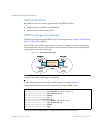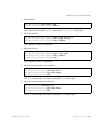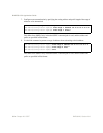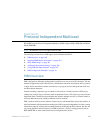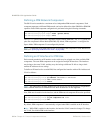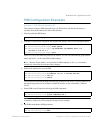
BLADEOS 6.5.2 Application Guide
304 Chapter 21: Protocol Independent Multicast BMD00220, October 2010
PIM-SM is a reverse-path routing mechanism. Client receiver stations advertise their willingness to
join a multicast group. The local routing and switching devices collect multicast routing
information and forward the request toward the station that will provide the multicast content.
When the join requests reach the sending station, the multicast data is sent toward the receivers,
flowing in the opposite direction of the original join requests.
Some routing and switching devices perform special PIM-SM functions. Within each receiver
domain, one router is elected as the Designated Router (DR) for handling multicasts for the domain.
DRs forward information to a similar device, the Rendezvous Point (RP), which holds the root tree
for the particular multicast group.
Receiver join requests as well as sender multicast content initially converge at the RP, which
generates and distributes multicast routing data for the DRs along the delivery path. As the
multicast content flows, DRs use the routing tree information obtained from the RP to optimize the
paths both to and from send and receive stations, bypassing the RP for the remainder of content
transactions if a more efficient route is available.
DRs continue to share routing information with the RP, modifying the multicast routing tree when
new receivers join, or pruning the tree when all the receivers in any particular domain are no longer
part of the multicast group.
Supported PIM Modes and Features
For each interface attached to a PIM network component, PIM can be configured to operate either
in PIM Sparse Mode (PIM-SM) or PIM Dense Mode (PIM-DM).
PIM-SM is used in networks where multicast senders and receivers comprise a relatively small
(sparse) portion of the overall network. PIM-SM uses a more complex process than PIM-DM
for collecting and optimizing multicast routes, but minimizes impact on other IP services and is
more commonly used.
PIM-DM is used where multicast devices are a relatively large (dense) portion of the network,
with very frequent (or constant) multicast traffic. PIM-DM requires less configuration on the
switch than PIM-SM, but uses broadcasts that can consume more bandwidth in establishing
and optimizing routes.







